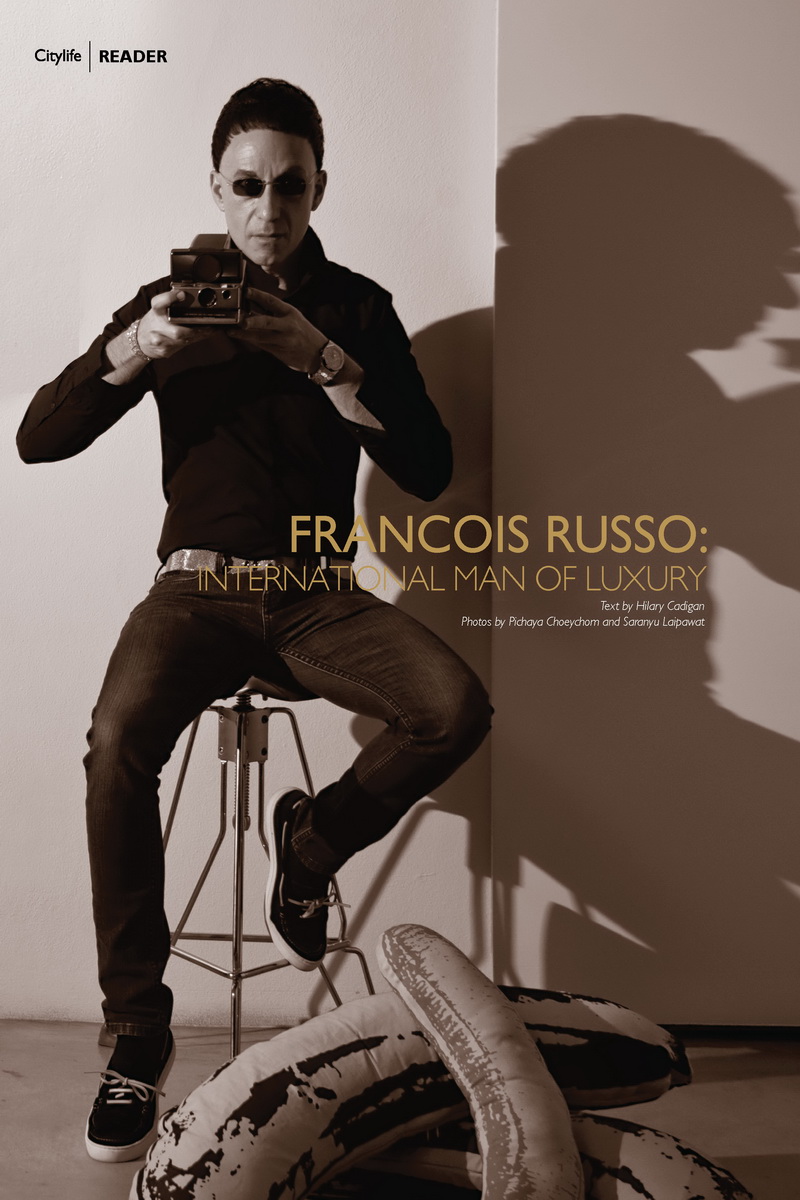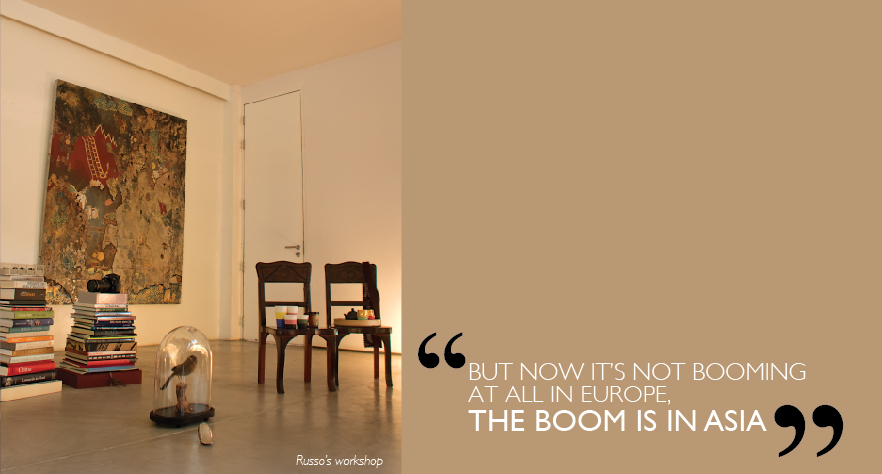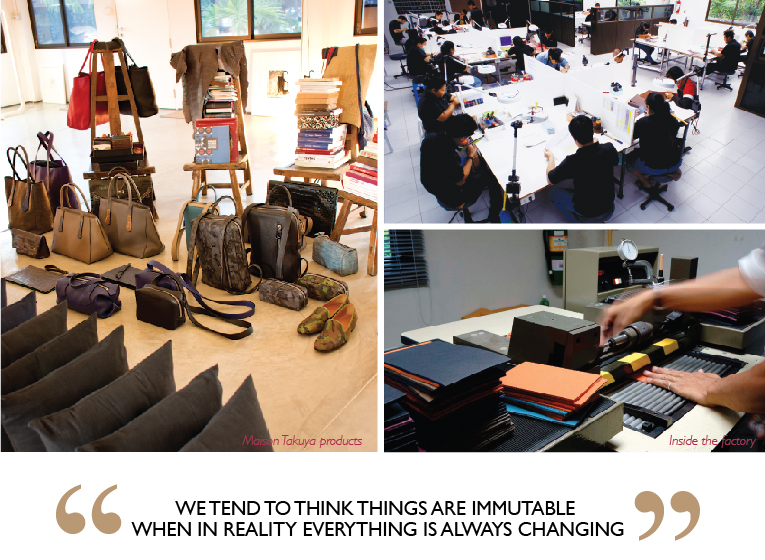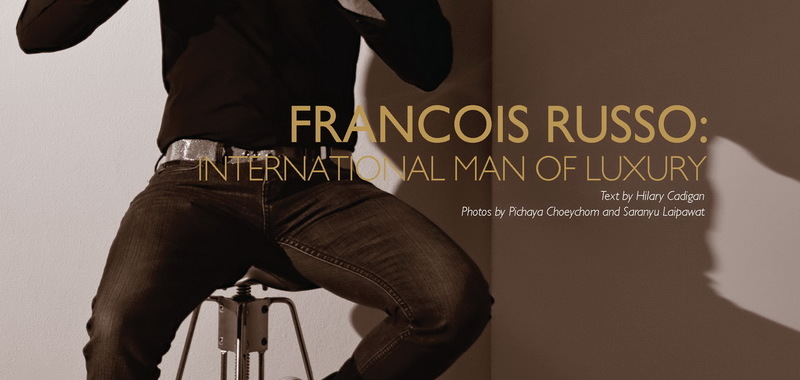
From the outside, Maison Takuya’s headquarters don’t look like much. A low, grey building, nondescript in every way, located in the outskirts of Chiang Mai. It has no sign at the entrance, and at first we’re not even sure we’re in the right place. But this is the home, studio and factory of Francois Russo, an international French designer who specialises in luxury leather handbags under the brand Maison Takuya.
It’s a brand you might not have heard of, but Russo is fine with that. Business is booming across the globe, from Japan to Europe to the Americas, and Maison Takuya’s celebrity clients include everyone from Mick Jagger to Bar Rafaeli to Frank Gehry to Karl Lagerfeld.
Unlike any other luxury brand in the world, each and every Maison Takuya product is completely handstitched by a team of 120 Thai craftsmen right here at the Chiang Mai factory, using precious leathers imported from all over the globe – cowhide from Italy, ostrich from South Africa, crocodile from Hermès’ private tannery in France. The result is what Russo calls “the Rolls Royce of leather goods,” and his customers, not to mention the international media, seem to agree. Maison Takuya handbags sell for up to 80,000 euros a pop (that’s over three million baht) and Russo has amassed over 300 pages worth of magazine coverage, despite the fact that he has never commissioned a single advertisement (“Never! I hate it!”).
A CEO at Gucci once said, “We are not in the business of selling handbags, we are in the business of selling dreams,” Russo tells me, smiling coyly. “Here, it’s the opposite. We are not in the business of selling dreams, we are in the business of selling bags.” That and iPhone cases – Maison Takuya was the first brand ever to make them out of precious leather, starting back in 2008.
“Fashion dies young,” says Russo. “Luxury is about things that last.”

Francois, In Person
Francois Russo himself is a projection of his brand; or rather, the brand is a projection of Francois Russo. Meticulous yet playful, with a jet black pudding bowl haircut that he trims himself and rimless black sunglasses he is not afraid to wear indoors, Russo has all the markings of an iconic designer. My Thai photographers declare him Andy Warhol and plan their cover shoot accordingly.
Russo is in his 40s and speaks eloquently with a French accent; when he removes the glasses his deep brown eyes reveal his enthusiasm. He wears the same exact outfit every day: black jeans from Lee (“because they fit me and they are cheap”), a black button-down shirt from Calvin Klein (he has 30, all identical, that he gets re-dyed every three months to keep their deep black colour), and a full metal belt from Hermès. “I have a few pairs of shoes but I rarely change them,” he says, showing me his favourite pair, which are leather and over 20 years old.
Russo lives most of the time at his Chiang Mai studio – his bedroom is attached, sparse but luxurious with a large bed and a freestanding bathtub in the middle of the room. The studio itself, far more impressive from the inside than the outside, is a veritable museum, like a more immaculate, intercontinental version of Warhol’s factory. The large, high-ceilinged space is dotted with a mix of Maison Takuya products, high profile art pieces (a tiny Jeff Koons bird sculpture placed inside an antique bird cage, a wall-sized painting by up-and-coming Thai artist Pannaphan Yodmanee) and inexpensive but carefully placed trinkets – a small electric train, a wooden hand with moving joints, a piece of dim sum carved from jade sitting in a tiny wheelbarrow.
“This bird here is talking to that bird there,” says Russo, pointing to a taxidermied sparrow under glass with a sleek avian sculpture placed beside it. “I like to install dialogues, improbable encounters with things that can talk to each other. Design is that, really!”
From There to Here
According to Russo, all the big luxury brands that we know of today – Burberry, Louis Vuitton, Hermès, to name just a few – were born in the 19th century, during Europe’s big boom.
“But now it’s not booming at all in Europe,” he continues. “The boom is in Asia.” And that is why Russo, who originally intended to start his brand in France, ultimately decided to go east.
“Before I started Maison Takuya, I had taken over 70 trips to Japan,” he tells me. And indeed the brand’s name derives from the Japanese word “takuetsu” which means excellence and “takumi” which means artisan (while “maison” gives a hometown nod to 19th century France).
“I have been captivated by Japanese culture ever since the time I was attracted by the idea of minimalism, expressing luxury through subtraction instead of addition, perfection through simplicity instead of ornament,” says Russo. “Therefore my desire to inject Japanese DNA into the brand was resolute.”

However, it wasn’t until he took his first trip to Thailand in 2007, to partake in an exhibition on European designers at Bangkok’s Jim Thompson House, that Russo found his ideal locale. “Later that same year I was on my way to Bali, which is where I was planning to start the brand, but I came back to Thailand first and said, well, no reason to go to Bali anymore!”
Russo says he had a feeling then that Thailand held the future of luxury design.
“Do you still feel that way?” I ask him.
“Oh, absolutely!” he replies. “Now more than ever.”
He smiles and shakes his head. “France lost the idea of natural style decades ago. When you look at people in the street, they are not elegant. Not because they don’t spend money, but because they don’t have that natural sense of elegance anymore and only add up branded items. In France, people dress like potato bags.” I laugh. “Seriously!” Russo squeals. “All grey.”
Meanwhile, he is quick to praise Thailand’s thoroughly different approach. “Thais have a natural attitude, a sense of style and colour. It’s interesting to judge countries by what you see in the street. Here you see people mixing and matching. Thais like to play with clothes, even with a low budget. I often tell the media that Thailand is the Italy of Asia, and it’s true.”
While Bangkok was his initial destination, Russo soon moved the operation to Chiang Mai, where he says there is less employee turnaround and more brand loyalty. “I try to manage this company as an orchestra,” he says. “I believe a brand should play some kind of music that is specific to the brand. After people believe they belong to the orchestra, they’re not tempted to leave anymore. They want to stay.”
In the Belly of the Beast
When you think of the word “factory,” the first thing that probably comes to mind is noise. Loud, clanging machines, maybe clouds of noxious fumes, thick layers of dust (or maybe this is just me recalling my seventh grade lessons on 19th century American textile mills). Regardless, entering into the Maison Takuya factory – if you could even call it that – is an unexpectedly pleasant experience. It’s clean, well-lit and almost oddly quiet. The warm, buttery scent of leather fills the air, and young Thai workers, many covered in tattoos and piercings, sit at tables, calmly cutting, stitching and sanding away. Russo takes me from station to station, fussing occasionally. “See?” he says. “No sewing machines.”
From hanging hide to finished product, some bags can take up to 40 hours to complete. Each is made entirely of leather – no cardboard or plastic inserts here, unlike most brands – and designed entirely by Russo himself. The bags are simple and elegant, with no hints of trendiness. The quality is obvious, even to a luxury neophyte like myself. And above all, each product is built to last.
“A thing of beauty is a joy forever,” Russo says dreamily, quoting Keats.
At the factory, each craftsman has his or her own specific task, and the pieces pass swiftly from one station to another, the workers initialing an itemised checklist as each step is completed.
“What happens if they mess up?” I ask, eyeing a particularly expensive looking piece of indigo croc skin.
“They rarely do,” replies Russo. But there are consequences. First offense takes an individual pay cut, second means a cost deduction for the entire team. “They don’t want that!” says Russo with a wink, an arm slung across my shoulders. “But I’m a bit of a perfectionist.”
He rushes over to a table in the new products area. “Oooh, isn’t that beautiful!” It is a brand new product: a candy-coloured leather pen case, cut just so. “Very well done,” he tells the craftsman, giving him a pat on the back.
A Passion, a Philosophy
Returning to the studio, I ask Russo what may be an overly simplistic question: why bags?
He doesn’t flinch. “My passion for bags comes from the idea that as human beings we are all wanderers,” he says. “We tend to think things are immutable when in reality everything is always changing. The only thing we take with us are our bags. So why not the best possible bag?”
With a smile and a nod, I nudge my fraying pleather Liz Claibourne carryall under the table a little further.
